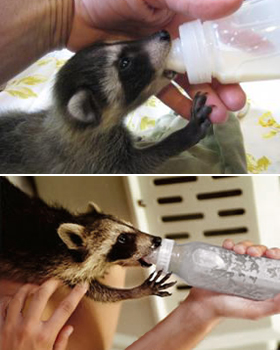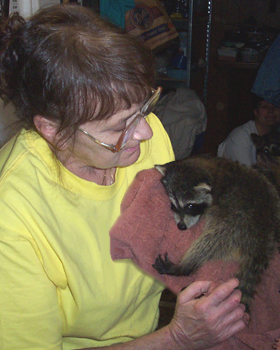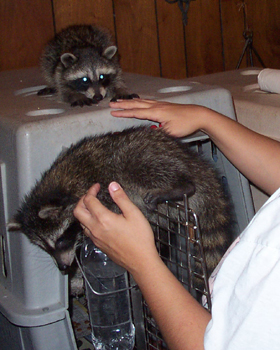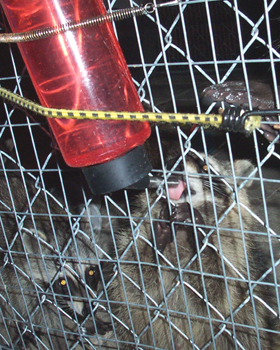ARE YOU SURE? - First and foremost, please be sure that the raccoon is
orphaned. It's not uncommon for a young raccoon to wander off while mom is away gathering food, and she is well-equipped to find her young
again and care for it as nature intended. Take possession of and care for baby raccoons only when you are certain the mom won't come back.
IS IT LEGAL TO PICK THEM UP? - In most states, it's okay to handle them and bring them to a
licensed rehabber. It's often not legal to keep them yourself, as a pet. Check out our locations page for
the laws in your state or city.
RISK OF DISEASES? - It's not likely that you'll contract a disease, but perhaps the raccoon is abandoned because it's sick. Wear leather gloves when picking up a raccoon for the first time. This can protect
you against biting. Check for fleas as well.
CARE FOR IT ON YOUR OWN? - Okay. In case of emergency, if you cannot find a local licensed rehabber, or for any reason that you need to care for it on your own to give it the best chance of survival, we offer the below suggestions.
And don't be afraid to contact us or call a rehabber out of your area to ask for advice!
KEEP THEM WARM - The first step. It's very important that any
orphaned baby raccoons be kept warm. A raccoon's normal body temperature is 101-103°F, but babies do tend to run a little cooler than that.
Smaller orphaned raccoons often have subnormal body temperatures because they have little hair. Warming them is important, particularly if they are cold. But they must not be warmed too quickly, or to too high a temperature - that
could kill them! A warm water bottle or heating pad, set on lower settings, is best.
REHYDRATION FIRST - Do not attempt to feed a baby raccoon unless you know it is properly hydrated. Feeding it first can kill it. Also, do not attempt to rehydrate a raccoon until you know it is warm, at least 101 degrees. Then you
can give the raccoon fluids through a baby bottle with nipple. You can use pedialyte, or you can mix 1 pint of boiled/distilled) water, 1 teaspoon of sugar, and 1/3 teaspoon of salt. Rehydrate every hour or so, 3 or 4 times.
INFANT FEEDING - Do not feed it cow's milk or anything other than kitten milk replacement formula. Mix 1 Part Powder to 2 1/4 parts water. If the babies are constipated, increase the water ratio. To feed place babies on the stomach,
and let them suck vigorously at a bottle. If they slow down, remove the bottle, to prevent overfeeding. A little tummy rubbing will help promote bowel movements, which is important. Overall touching, burping, can help.
FIRST 8 WEEK FEEDING SCHEDULE
0-1 weeks (baby is a tiny 4", pink nearly hairless): 4-6 cc every 2 hours and once through the night.
1-2 weeks (baby is 5-6" long, sparse fur, eyes closed): 6-8 cc every 2 hours and once through the night.
2-3 weeks (baby is 8-10" long, eyes still closed): 15-30 cc every 3 hours.
3-4 weeks (baby 10-11" long, eyes open): 50-60 cc every 3-4 hours.
4-8 weeks (baby 12-14"long, ears open, start to walk): 60 cc every 4 hours.
ADULT FEEDING - At 8 weeks, transition to solids. At first, expand the bottle nipple hole and mix some soft puppy food in with the milk. Transition to solids over 2-4 weeks. Puppy food is good for the bulk of the diet at first, then dry dog food,
with some fruits as well. Raccoons will sell their soul for grapes.
WHAT TO STORE THEM IN? - A cardboard box is okay, at first. A pet crate will also do. An electric heat pad is necessary for the first two weeks, on low setting. Blankets or towels are nice. Some people say to avoid these for fear of claws becoming ensnared, but we have never found this to be the case.
For longer term care, you'll need proper housing, such as a very large crate or pen, with water supply. Generally, move them to a large
outdoor pen once they eat solids, by age 10 weeks. Give them a litter box, and be diligent about cleanliness, in case the feces contain roundworm (Baylisascaris procyonis) the parasite of greatest concern when handling raccoons, as it is transferrable and
even fatal to humans and pets.
WHAT HEALTH CARE? - A licensed rehabber will usually provide health care including the following: Roundworm Treatment with Pyrantel Pamoate sold under the name NEMEX, given orally at weeks 2, 3, 4, 6, 8, 10 and then once per month after that.
Rabies Vaccine and Canine Distemper Vaccine and Parasite treatment for fleas and ticks.
RELEASE INTO WILD - It's good to release them when at least 14 pounds and at least 18 weeks old. To help ensure survival, release into an area that provides adequate survival resources. This is a skill unto itself, which requires and understanding
of raccoon behavior and local ecology, current population densities, etc. The raccoon will fare better if slowly introduced to the habitat over a period of time, with periodic feeding. Most raccoons in the wild (or should we often say urban wild) were brought up as wild animals, with a loving mother
raccoon who teaches them how to survive. Relocation after raccoon rehab can be hard on the animals. We do not recommend keeping an adult raccoon as a pet. Read more about pet raccoons.
Those are the basics, and by no means is this list of instructions comprehensive. A licensed wildlife rehabilitator will have learned many techniques through trial and error over the years. Rehab is not easy, it is not guaranteed success, and it is a
labor of love. The best care for a growing raccoon is its own mother. That failing, the care of an experienced rehabber. No one should attempt raccoon rehab unless it is absolutely necessary. No one said raccoon rehabilitation was easy!
Additional Resources




